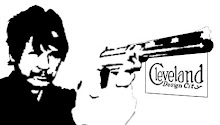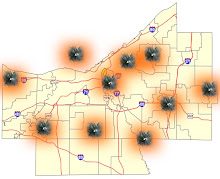Overall, 2007 has been quite a year for design endeavors in Northeast Ohio. Interesting buildings are being designed or are nearing construction, design literacy is growing and starting to be appreciated by a wider swathe of Clevelanders, and design has been a topic of intense discussion at exhibitions, cocktail parties, in newspapers and the blogosphere. Young architects were exhibited, the Cleveland Competition completed its first annual competition, international-caliber designers lectured, and senior architects imparted their wisdoms and dreams about Cleveland Modernism. Let’s hope for more of the same in 2008.
However, we here at Blog on the City wish to present the several “design awards” for the past year, praising the worthy while ridiculing the awful. We hope you enjoy and cringe at the appropriate intervals.
Best Building completed in 2007:
Coop Himmelblau’s Akron Art Museum
Although the Washington Post critiqued the new addition as an appropriate 1970’s intellectual imposition in a city mired in the 1970’s, Coop’s building is a forceful, potent, startling, and correct architecture. The structural gymnastics, folding planes of glass, aggressive concrete presence, and resulting spatial arrangements will hopefully teach conservative Northeast Ohioans that architecture can transcend Western Reserve-style gables, plastic columns, and “brick” facades.
The Missed Opportunity of 2007:
Robert P. Madison’s Tri-C Arts Center + Rock Hall Archive
We all know why Madison gets local design projects—he is the most politically networked architect in the city. However, he is the most incompetent architect working on large scale commissions in the city, as is evident in the proposed Tri-C Arts center to be located at the Downtown Metro Campus. The massing is boring, lifeless and diluted brutalism. The fenestration is lifeless. A campus orientation for the building is beguiling absent. The relationship to Interstate 77 is non-existent. One has to ask how this hunk of architectural garbage was allowed to pass through the many layers of design reviews or the enlightened intellect of Tri-C and Rock Hall leadership. Local leadership missed an opportunity to create a thoughtful architectural repository for musical history.
Best Urban Design Strategy Proposed in 2007:
The Innerbelt Cap
Yeah, it would be expensive. But we have wasted more money on other infrastructural elements in Cuyahoga County. The Inner Belt Cap would essentially bury the Inner Belt and connect the Tri-C campus and the Saint Vincent Medical Campus with Cleveland State, which would be worthwhile. The application of the cap could spawn a new urbanism, not New Urbanism, unlike the proposed block copy and extension proposed by self-describe urban designer Paul Volpe. This study is worth continued exploration, hopefully devoid of the saccharine neo-traditionalism espoused in the study. Can the scar through the city still be acknowledged in the scar tissue?
The most Unfortunate Urban Design Strategy Proposed in 2007:
The Innerbelt Bridge
The people that bring you orange barrels 9 months of the year are also planning a rather uninspiring new bridge to replace the existing Innerbelt spans across the Cuyahoga Valley. Bridge designers presented some rather banal solutions to a potentially invigorating design problem, all the while pissing-off one the leading bridge design consultants in the world. Infrastructural investments like this one will affect downtown urbanism for generations, although it seems the ODOT really does not care. Let’s hope Frank Jackson, City Council, and the County Commissioners stand-up and do something about this potentially devastating project.
Best use of Architecture to shame Politicians:
The Breuer Tower Debacle
Now, mind you, the so-called “leaders” of Cuyahoga County seem a bit dim-witted, so embarrassing them is not that entirely trying. However, the Breuer Tower tug-of-war that played-out this entire year exposed the potential of an energized architectural community as well as the fiscal mismanagement of Cuyahoga County. Several boosters sponsored forums, design competitions, and even protests in order to bring some publicity to the plight of Marcel Breuer’s only skyscraper. Entrants in the design competition and several bloggers pilloried city and county leaders for their lack of tact, lack of historical perspective, and exposed the flaws in their logic for demolition. In the end, or at least as of now, the county has no money to build anything, so the building may be sold and ultimately saved.
Best Advocates for Design (Large Institutions):
Dr. Toby Cosgrove, CEO-Cleveland Clinic
Timothy Rub, Director-Cleveland Museum of Art
Each of these University Circle leaders can and do exert influence over architectural and urban design not only in the confines of the Circle, but all over the Northeast Ohio region.
Toby Cosgrove, a minimalist modernist, personally reviews and critiques every new Clinic facility that will be constructed. Cosgrove pushes his architects to transcend the normative empty formalism that is found in much medical design (see the new Clinic Heart Center under construction)—and his advocacy of an astute and responsible architecture will leave a lasting legacy within the Clinic system and the region.
Timothy Rub is an exacting architectural historian who also pushes his architects to refine, re-engage, and re-consider every notion of design. Rub, with his cadre of leading architects, landscape architects, and designers, are transforming the Cleveland Museum of Art into a lively collection of design impositions, each piece referencing and re-interpreting Marcel Breuer’s modernist propositions. Rub’s intimate involvement with each facet of the restoration and additions will ensure architectures of high quality, erudite reasoning, and superior pedigree.
Best Advocate for Design (Small Institutions):
Greg Peckham, Executive Director-Cleveland Public Art
Greg Peckham and his staff at Cleveland Public Art continued to work in the various arenas of public art, from the erudite and permanent, to the populist and temporary. Whether utilizing concrete, landscape, or spray paint, Cleveland Public Art’s Executive Director is constantly working to enliven Cleveland’s public spaces and corridors. Look for challenging work to emerge on Mall B this upcoming year, again spearheaded by Peckham.
Best Net-roots Activity for Design:
Cleveland Design Competition
Local young architects Brad Fink and Mike Christoff launched the inaugural Cleveland Design Competition this year, a competition designed to attract design attention to our fair city and region. Fink and Christoff must be congratulated for not only creating such a competition that garnered international participation, but also for protecting the integrity of the endeavor, avoiding unnecessary entanglements with traditional organizations and personalities that wanted to influence the competition. We look forward to next year’s competition program.
Monday, December 31, 2007
Friday, December 28, 2007
Praise and Ridicule Forthcoming

We here at BOTC, in conjunction with Cleveland Design City, will be posting our year-end awards and commentary on the year that was 2007. We will be posting awards and ridicule about buildings, proposals, urban design schemes, infrastructural projects, architects, activitsts, and patrons that moved Cleveland design forward or inflicted irreversible harm.
Look back here on Monday for our "authoritative" take on a rather wonderful and active year in Cleveland architecture and maybe some resolutions for 2008.
Wednesday, December 26, 2007
John Terrence Kelly, RIP
One of Cleveland's true Modernists has passed away.
See the Plain Dealer obituary here.
An exerpt about an architect's architect:
Known by family and friends as "U.J.," which stood for Uncle Jack, Kelly was described in a 1955 Plain Dealer story as an architect who would rather design than sleep, and would rather starve than compromise his ideals. Kelly was 33 then and had designed a booth at the Home and Flower Show for the now defunct Cleveland Press newspaper. The booth, constructed of illustrated Masonite panels mounted on a steel frame, reflected the two principles of design that Kelly prized above nourishment, the Plain Dealer reporter wrote: "Each design problem demands its own reasoned solution." And "building materials should be used to express their beauty and function."
RIP.
Subscribe to:
Posts (Atom)





